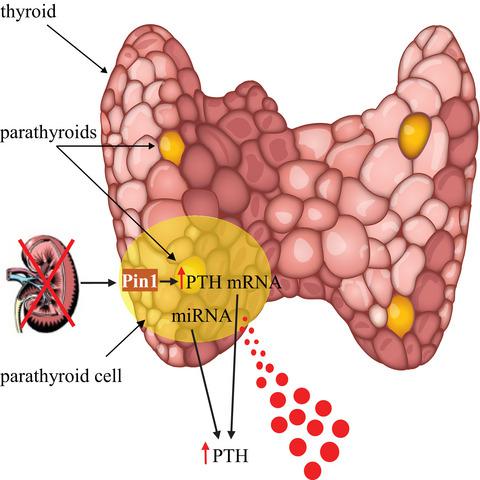Our official English website, www.x-mol.net, welcomes your feedback! (Note: you will need to create a separate account there.)
Post‐transcriptional mechanisms regulating parathyroid hormone gene expression in secondary hyperparathyroidism
The FEBS Journal ( IF 5.4 ) Pub Date : 2020-03-19 , DOI: 10.1111/febs.15300 Rachel Kilav‐Levin 1, 2 , Alia Hassan 1 , Morris Nechama 1, 3, 4 , Vitali Shilo 1 , Justin Silver 1 , Iddo Z. Ben‐Dov 5 , Tally Naveh‐Many 1, 4
The FEBS Journal ( IF 5.4 ) Pub Date : 2020-03-19 , DOI: 10.1111/febs.15300 Rachel Kilav‐Levin 1, 2 , Alia Hassan 1 , Morris Nechama 1, 3, 4 , Vitali Shilo 1 , Justin Silver 1 , Iddo Z. Ben‐Dov 5 , Tally Naveh‐Many 1, 4
Affiliation

|
Parathyroid hormone (PTH) regulates serum calcium levels and bone strength. Secondary hyperparathyroidism (SHP) is a common complication of chronic kidney disease (CKD) that correlates with morbidity and mortality. In experimental SHP, the increased PTH gene expression is due to increased PTH mRNA stability and is mediated by protein–PTH mRNA interactions. Adenosine–uridine‐rich binding factor 1 (AUF1) stabilizes and K‐homology splicing regulatory protein (KSRP) destabilizes PTH mRNA. The peptidyl‐prolyl cis/trans isomerase Pin1 acts on target proteins, including mRNA‐binding proteins. Pin1 leads to KSRP dephosphorylation, but in SHP, parathyroid Pin1 activity is decreased and phosphorylated KSRP fails to bind PTH mRNA, leading to increased PTH mRNA stability and levels. A further level of post‐transcriptional regulation occurs through microRNA (miRNA). Dicer mediates the final step of miRNA maturation. Parathyroid‐specific Dicer knockout mice that lack miRNAs in the parathyroid develop normally. Surprisingly, these mice fail to increase serum PTH in response to both hypocalcemia and CKD, indicating that parathyroid Dicer and miRNAs are essential for stimulation of the parathyroid. Human and rodent parathyroids share similar miRNA profiles that are altered in hyperparathyroidism. The evolutionary conservation of abundant miRNAs and their regulation in hyperparathyroidism indicate their significance in parathyroid physiology and pathophysiology. let‐7 and miR‐148 antagonism modifies PTH secretion in vivo and in vitro , suggesting roles for specific miRNAs in parathyroid function. This review summarizes the current knowledge on the post‐transcriptional mechanisms of PTH gene expression in SHP and the central contribution of miRNAs to the high serum PTH levels of both primary hyperparathyroidism and SHP.
中文翻译:

继发性甲状旁腺功能亢进症中调节甲状旁腺激素基因表达的转录后机制
甲状旁腺激素(PTH)调节血清钙水平和骨骼强度。继发性甲状旁腺功能亢进症(SHP)是慢性肾脏病(CKD)的常见并发症,与发病率和死亡率相关。在实验性SHP中,PTH基因表达的增加归因于PTH mRNA稳定性的提高,并由蛋白质-PTH mRNA相互作用介导。富含腺苷-尿苷的结合因子1(AUF1)稳定,K同源剪接调节蛋白(KSRP)使PTH mRNA不稳定。肽基脯氨酰顺/反异构酶Pin1作用于靶蛋白,包括mRNA结合蛋白。Pin1导致KSRP去磷酸化,但是在SHP中,甲状旁腺的Pin1活性降低,磷酸化的KSRP无法结合PTH mRNA,从而导致PTH mRNA稳定性和水平提高。转录后调控的进一步水平是通过microRNA(miRNA)实现的。Dicer介导了miRNA成熟的最后一步。甲状旁腺特异性切块机甲状旁腺中缺少miRNA的基因敲除小鼠正常发育。出乎意料的是,这些小鼠对低钙血症和CKD均不能增加血清PTH,这表明甲状旁腺Dicer和miRNA对刺激甲状旁腺至关重要。人类和啮齿动物甲状旁腺共享相似的miRNA,在甲状旁腺功能亢进症中发生改变。丰富的miRNA的进化保守性及其在甲状旁腺功能亢进中的调控表明它们在甲状旁腺生理和病理生理中的重要性。let-7和miR-148拮抗作用可在体内和体外改变PTH的分泌,提示特定miRNA在甲状旁腺功能中的作用。这篇综述总结了有关SHP中PTH基因表达的转录后机制的最新知识,以及miRNA对原发性甲状旁腺功能亢进和SHP的高血清PTH水平的重要贡献。
更新日期:2020-03-19
中文翻译:

继发性甲状旁腺功能亢进症中调节甲状旁腺激素基因表达的转录后机制
甲状旁腺激素(PTH)调节血清钙水平和骨骼强度。继发性甲状旁腺功能亢进症(SHP)是慢性肾脏病(CKD)的常见并发症,与发病率和死亡率相关。在实验性SHP中,PTH基因表达的增加归因于PTH mRNA稳定性的提高,并由蛋白质-PTH mRNA相互作用介导。富含腺苷-尿苷的结合因子1(AUF1)稳定,K同源剪接调节蛋白(KSRP)使PTH mRNA不稳定。肽基脯氨酰顺/反异构酶Pin1作用于靶蛋白,包括mRNA结合蛋白。Pin1导致KSRP去磷酸化,但是在SHP中,甲状旁腺的Pin1活性降低,磷酸化的KSRP无法结合PTH mRNA,从而导致PTH mRNA稳定性和水平提高。转录后调控的进一步水平是通过microRNA(miRNA)实现的。Dicer介导了miRNA成熟的最后一步。甲状旁腺特异性切块机甲状旁腺中缺少miRNA的基因敲除小鼠正常发育。出乎意料的是,这些小鼠对低钙血症和CKD均不能增加血清PTH,这表明甲状旁腺Dicer和miRNA对刺激甲状旁腺至关重要。人类和啮齿动物甲状旁腺共享相似的miRNA,在甲状旁腺功能亢进症中发生改变。丰富的miRNA的进化保守性及其在甲状旁腺功能亢进中的调控表明它们在甲状旁腺生理和病理生理中的重要性。let-7和miR-148拮抗作用可在体内和体外改变PTH的分泌,提示特定miRNA在甲状旁腺功能中的作用。这篇综述总结了有关SHP中PTH基因表达的转录后机制的最新知识,以及miRNA对原发性甲状旁腺功能亢进和SHP的高血清PTH水平的重要贡献。


























 京公网安备 11010802027423号
京公网安备 11010802027423号